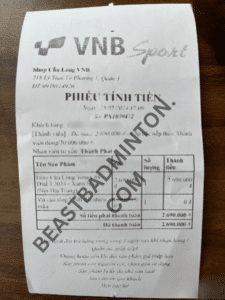
Yonex officially calls this unisex shoe the Power Cushion 88 Dial. But since the previous Dial 2 model is still available here and there, I’ll be referring to this one as the 88 Dial 3 to avoid any confusion as that’s how it’s being named at stores where they sell both (if you’re in doubt, ask them for the 2024 model).
The style of this shoe is also similar to the Yonex Power Cushion Infinity. That model is older and comes with two BOA dials instead of shoelaces, whereas this 88 Dial only has one as the easiest way to recognize the difference.
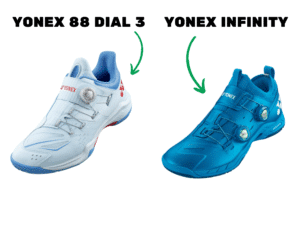
Despite the high price for the Infinity-model, it comes with Yonex’s older outsole grip, which suggests that this model will either be phased out soon or upgraded.
The Yonex 88 Dial 3 was released in April 2024 and I’ve yet to notice any professional player use it on the World Tour.
That being said, I could see it happening as it’s an all around shoe and surprisingly lightweight with some injury-preventive features and soft mesh on the inside. To my surprise, my size 28.5 CM (44.5 in EU) came in 2% lighter than the popular Yonex 65z3.
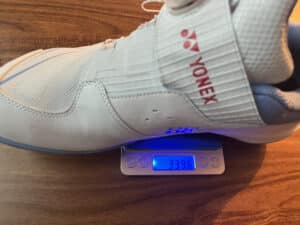
Here’s where it falls in my badminton shoe matrix.
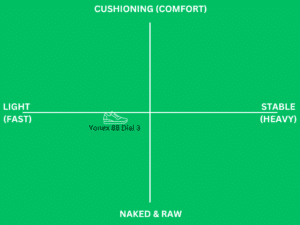
Yonex 88 Dial 3 review and my experience
Now, let’s dive into the 88 Dial 3 review.
(This review is also available on video)
Table of Contents
Unboxing and first impressions
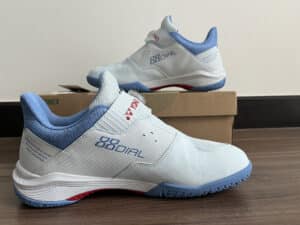
At first glance, this shoe seems like the splurge option from Yonex as it comes in at a price that’s slightly higher than other top-tier Yonex badminton shoes in the countries I looked at. I later realized that this was probably due to the extra cost of the BOA dials.
It was surprisingly hard to figure out how to open the BOA dials the first time as I wasn’t sure how sturdy they were and I didn’t want to break them right out of the box.
As usual with my shoe reviews, I’ve had these bad boys on court for ten hours to test how they feel while playing as an intermediate player.
Let’s see how they play!
Fit + upper shoe area
I was pleasantly surprised wearing these shoes on court as the interior material feels like a nice soft sock, similar to what I experienced while testing Mizuno’s Wave Claw 3.
The injury-preventive characteristics around the heel and upper (which I’ll get to in a minute) gave a nice snug feeling without being too soft and loose like you might have experienced with shoes that go all in on a thick cushion.
Top-tier Yonex badminton shoes tend to have a stiffer feel than other brands in my experience, and this pair is no different.
I naively first assumed that the BOA dials were a fun and easier alternative to tying shoelaces. While that is a part of it I’ve come to like, I found that the real benefit for me was in being able to adjust the fit more precisely to my liking. Especially, if something felt loose while playing, it was easier and quicker to adjust between rallies than with shoelaces.
I’ve come to like this a lot.
Especially, when you compare it with the annoying tongue I’ve found on many badminton shoes that often slide down the side while playing and need regular adjustments. The tongue on the Yonex 88 Dial 3 was nice and wide and I didn’t have any issues with it sliding down the side.
The fit felt so snug that I was confident that my feet wouldn’t move within the shoe, similar to what I noticed in the Eclipsion Z3. If you’re into that lightweight boot-like quality, you’ll like this model.
I had noted down just once that the shoe felt fairly hot towards the end of a demanding session. That surprised me due to the otherwise low weight. The sides do feel somewhat sealed without clear see-through material that suggests breathability and combined with the higher heel and ankle area, that must be what caused it.
On the other hand, I didn’t think about it during the other sessions where I was playing in this shoe.
Overall, the sides and upper was another positive of this shoe. Combined with the tall ankle area for injury prevention, I found this to be terrific for us adult players who are concerned with injuries like rolling your ankle.
The outsole and grip
The Radial Blade grip that Yonex has applied to this outsole is as superb as usual, and my favorite among badminton shoe brands.
They’ve kept the outsole in two pieces, rather than combining it into a one-piece which usually gives a more stable landing, like on the Eclipsion Z3. That suggests that this shoe isn’t going all in on injury prevention.
Insole
I didn’t think about the insole once while playing in this pair, which is a positive in my book since other lightweight shoes I’ve tested tend to make my feet slip within the shoe.
It doesn’t come with the nicer wave pattern you might recognize from the popular SHB 65z3, but it strikes me as slightly thicker, softer (and better) than in the ultra-lightweight Aerus Z2.
The ventilation holes are a nice touch too.
The heel area
The heel is damn exciting in the Yonex 88 Dial 3.
It’s tall, nicely stiff, sturdy for good injury protection, and has a snug fit, all while applying the thickest sausage cushion I’ve come across thus far.
I’m usually not a big fan of the sausage cushion, but the fit and soft material on this model works well and I’m pleasantly surprised. It runs from side to side across the heel and gives possibly the best fit I’ve tried in a Yonex shoe.
Cushion and shock absorption
The midsole reminds me of the 65z3 both under the foot and toes. It has a tad of padding, but not enough to prevent fatigue for me.
I wish it had slightly more. It’s not a deal breaker for me, but it isn’t that fun either.
Durability
When it comes to durability, I like to look at two clues to get an idea of how it’s holding up. The first, the outsole tear on the non-racket foot, has no issues and looks good.
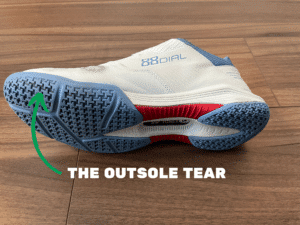
The lunge tear on the non-racket foot doesn’t look like it’s in particularly good shape, but I’ll give it the benefit of the doubt for now since it often looks worse on shoes in brighter colors.
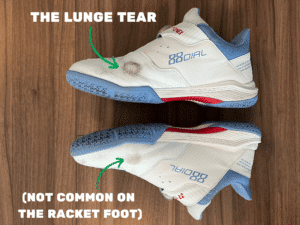
But I have a sneaking suspicion that it isn’t that durable due to the low weight and the fact that both shoes seem to have taken a beating, which usually only happens on the non-racket foot for me. But I can’t conclude that just yet, which is why it gets a score on the higher end.
The toe area and protection
The last item in this Yonex 88 Dial 3 review is the toe box.
As is the case with most high-end Yonex badminton shoes, the toe box feels stiff which becomes even more apparent due to the minimal cushioning. If you’ve tried the Yonex Comfort Z3, you’ll notice that this shoe has a toe box that feels similar.
To be frank: if your footwork isn’t great, you’re often late to the shuttle and are forced into lunges, expect to run into toe pain or similar fatigue issues as I have.
In fact, if my footwork doesn’t improve, this toe box will murder my toes in the long run. You better be ready for that, otherwise it’s an expensive choice of shoe if you’re only going to realize it later and then have to replace them with another pair.
I’ve found that most top Yonex badminton shoes tend to have a roomier toe box and this one seemed slightly narrower than usual… or at least the roomy-ness didn’t bother me as much which could be due to the issues with cushion at the front of the toe box being more prevalent for me (or it could be due to this being a unisex shoe).
The overall verdict
POSITIVE
Soft feeling mesh on the inside + epic fit.
NEGATIVE
The toe box kills my feet.
I came into this Yonex 88 Dial 3 review skeptical because of the high price tag and what I thought would be unnecessary BOA dials both in terms of weight and functional use.
I’ll have to heat my hat on this one as I’m pleasantly surprised and these shoes are more fun to play in than I had expected.

The 88 Dial 3 feels like a combo of the Yonex Eclipsion Z3 with the tall but stiff heel fit and the Yonex 65z3 in terms of weight and the limited cushion in the toe box.
As an intermediate player with mediocre footwork and some bad habits, this will be a rough shoe to play in in the long run for me, primarily due to the toe box.
I can live with the midsole cushion even if I prefer that it had more, but I’ll go as far as to say that this could’ve been my new favorite shoe if it wasn’t for the toe box. The stiffness and limited cushion there is a deal breaker for my body and I feel unnecessarily fatigued after playing in it.
Improving my footwork would help, but not for the sake of being able to play in a certain badminton shoe. There are too many other good options for me to bother just because of that.
Yonex, if you see this, please consider making a variation of this terrific shoe for us with shittier footwork.
Yonex 88 Dial 3 (2024): the verdict
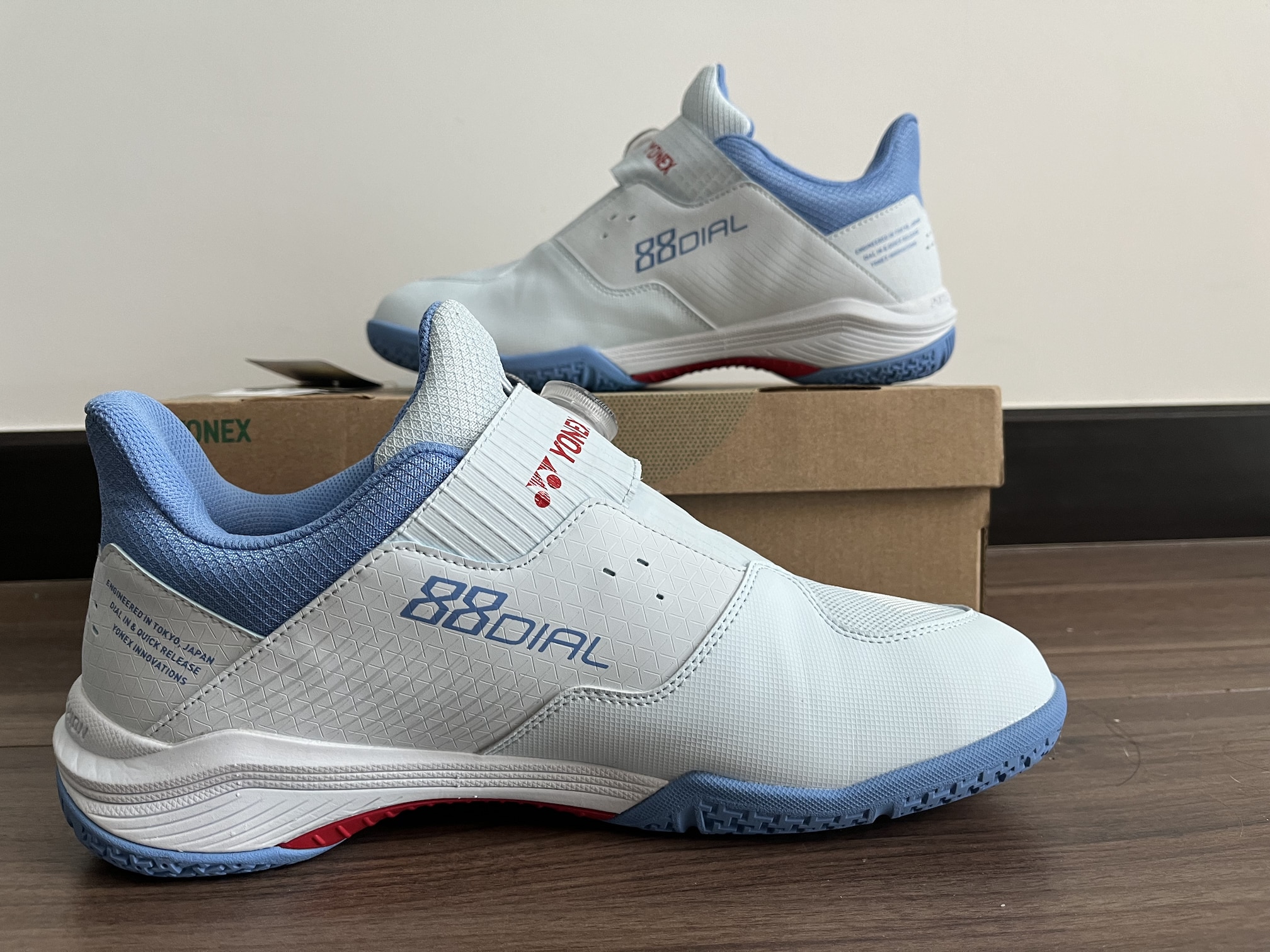
Summary + the beasty score
Yonex 88 Dial 3 (2024 model) offers a terrific fit and it’s easily adjustable with the BOA dials. I found those more fun than I had expected.
This shoe has the potential to be super popular if it wasn’t for the limited cushion in the toe box that makes my toes feel very fatigued after playing.
Which badminton players are best suited for Yonex 88 Dial 3
Next, let’s get a sense of which type of player this shoe is for.
Who Yonex 88 Dial 3 is suited for
This shoe is suitable for players with good footwork or those who don’t lunge and land heavily too often.
Players with an average or smaller body frame (due to the lightweight nature of this shoe) might also like this shoe.
Who Yonex 88 Dial 3 is not suited for
On the other hand, players with intermediate footwork and some bad habits, like me, who need more toe cushioning won’t like this shoe in the long run.
The same goes for heavy players who prefer more cushioning underneath their shoes.
Yonex 88 Dial 3 compared to other similar shoes
During my testing, I brought other similar pairs of shoes to compare head-to-head.
Yonex 88 Dial 3 vs Yonex 65z3
Since Yonex’s 65z3 is perhaps the most popular badminton shoe right now, it makes sense to compare the two as many players will be coming from this shoe.
To me, the fit in the 88 Dial 3 is better with the slimmer and soft mesh material inside the upper tongue area. This feels like it could be the next 65z3.
Though, I found it slightly less soft and with a more tight fit, especially with the higher ankle, even if that isn’t for everyone. The 65z3 has a thicker, softer, cushion as you’ll know from traditional cushioning in sports shoes.
I found myself feeling like I’d slip more while sweating a lot in the 65z3 as if it absorbed the sweat inside the shoe. It doesn’t feel as reassuring compared to the 88 Dial 3.
Yonex 88 Dial 3 vs Li-Ning Yun Ting 01
The reason I wanted to compare the Yonex 88 Dial 3 to Li-Ning’s Yun Ting is that they’re both in the all-around category with some injury-preventive features, like the high heel area.
The Yun Ting feels like it has a thicker cushion, which isn’t necessarily softer. The 88 Dial’s mesh material feels just as soft (if not more) while being stiffer and less thick, which is nice if you’re afraid of rolling your ankle in a cushion that’s too thick and soft.
Yun Ting’s sausage cushion feels softer around the ankle when you’re under pressure. It feels like an old-school vs new-school cushion.
The ankle and heel cushions feel similar, but the 88 Dial’s is thicker and stiffer, which is nicer for me. It locks the ankle in more whereas the soft side cushion around the ankle in the Yun Ting feels as if you’re more likely to roll the ankle.
As mentioned, both sport similar protective features around the ankle, like the high heel. The Yun Ting feels more snug on the sides even though the BOA dials are more fun and make it easier to perfect how tight you want it compared to traditional shoelaces.
Connecting the toe box and the rest of the outsole into a single piece tends to help with stability and suggests that the Yun Ting provides more of that to make it easier to keep a stable footing.
The toe box feels slightly less rough in the Yun Tin.
Overall, the Li-Ning Yun Ting feels like a heavier and more supportive variation of an all around shoe, whereas the Yonex 88 Dial 3 feels more like a similar lightweight edition.